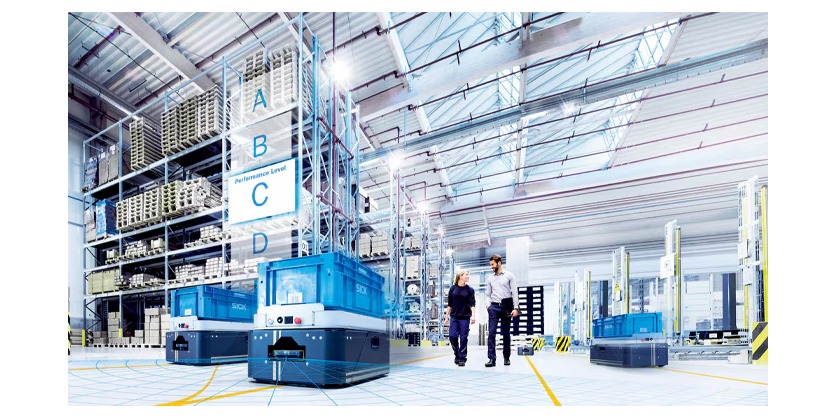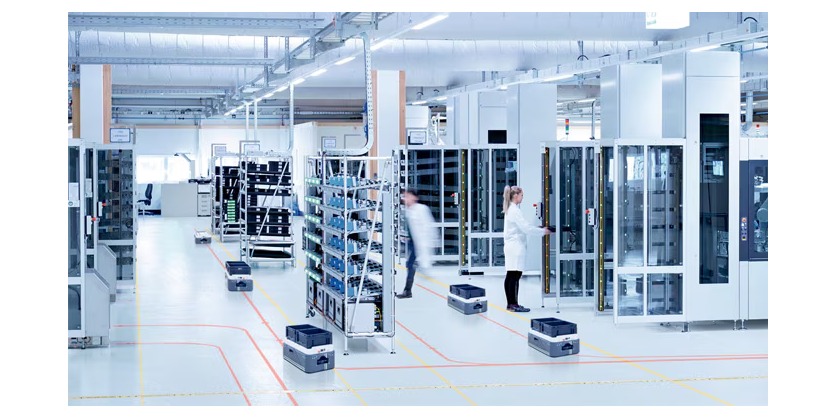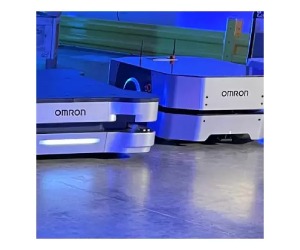Identifying, Assessing and Minimizing Risks: Designing Safe Mobile Robots
February 5, 2025

Mobile robots – whether it be automated guided vehicle (AGV) systems or autonomous mobile robots (AMRs) – are playing an increasing important role in mobile intralogistics because they significantly increase automation and efficiency in warehouses, production facilities and distribution centers. They general share their operating area with people. Special requirements on their design are therefore needed to ensure the safety of people, machinery and their environment. Olaf Zbikowski, Market Product Manager Industrial Safety at SICK Vertriebs-GmbH explains what safety aspects have to be taken into consideration so that operators of AGVs and the like are truly on the safe side.
When designing and constructing AGVs and mobile robots, manufacturers need to observe a whole bunch of current requirements and safety aspects. “At the same time, operators need to be able to rely at initial commissioning, during productive operation and when carrying out maintenance and repairs on the safety equipment of the vehicles, which – not least for liability reasons – are up-to-date with regard to the technology and the legal and normative requirements,” explains Olaf Zbikowski. “It is therefore necessary in the early project planning phase of AGV and AMR applications to identify risks, assess them, and take possible protective measures into consideration in the design from the outset.”
Risk assessment identifies hazards and possible safety measures

The safety specialist from SICK is referring here to the basis for the safe design of AGVs and AMRs: the risk assessment. It is prescribed both by the Machinery Directive 2006/42/EC (implemented in Germany in the ninth ordinance of the Product Safety Act) and, from January 20, 2027 by the Machinery Regulation (EU) 2023/1230.
“This means”, according to Olaf Zbikowski, “that the identification of hazards, the assessment and evaluation of safety risks, and the derivation of suitable safety measures for risk reduction and ideally risk prevention are essential for the development of safe mobile robots, AGVs, AGV systems and AMRs – including documenting the related processes and results.”
Three steps to a safe design
The persons responsible for design at manufacturers – if necessary in conjunction with SICK’s expertise as an experienced safety technology supplier – can carry out the risk assessment simply, safely and transparently using a three-step process. It starts with safe design, where possible sources of danger are already excluded in product design. To address any residual risks, suitable protective measures are selected. The aim here is to also take into consideration the requirements on the operational use of the AGV and AMR.
“The measures for risk reduction – and thus also the ongoing updating of the risk assessment after implementing a protective measure – must be repeated until the residual risk is acceptable or cannot be reduced by further protective measures,” explains Olaf Zbikowski regarding the practical procedure. The process concludes with notes in the operating instructions, warning signs, organizational measures, or the use of personal protective equipment.

Safety functions depend on vehicles, applications and operating environment
When selecting safety functions, various characteristics of the AGV and AMR need to be taken into consideration, e.g., the braking and stopping behavior, special aspects of the environment such as ambient light or contamination, application-specific circumstances such as mixed operation or the condition of the route, as well as foreseeable misuse such as persons riding along on the vehicle. “In principle, a variety of safety functions for risk reduction can be implemented,” and Olaf Zbikowski lists a few options: “initiating a stop and preventing an automatic restart, differentiating between man and material when entering or exiting a hazardous area in order to bypass safety functions there, or monitoring machine parameters such as speed, position or force.”

Modern technologies minimize collision and fall risks
When minimizing risks, the focus is increasingly on modern technologies where the protective devices can ideally further improve the flexibility and productivity of the vehicles. “This especially applies to safe 3D cameras, safety laser scanners modern safety controllers, and safety-certified encoders,” says Olaf Zbikowski. “When used in combination, they enable the routes of AGVs and mobile robots to be safely monitored and, when obstacles are detected or a person approaches, allow the vehicle to drive around them or slow down and come to a stop.”
And the state-of-the-art controller technologies in SICK’s safety portfolio can do even more. If, for example, AGVs are not guided along a fixed route and there are steps, ramps, elevators or the like in the operating area of the vehicle, a safe detection of height differences in the direction of travel is required. “In such usage scenarios,” says Olaf Zbikowski, “safety laser scanners, camera systems or distance sensors ensure a reliable ‘cliff detection’. And at load transfer points as well, risks to people can be reliably minimized using safe sensor solutions for presence, position and contour detection.”
AGVs and AMRs are an integral part of modern networked logistics and production processes and play a key role in the shift towards fully automated and smart warehouses. With SICK’s expertise as an experienced safety technology supplier in modern production and logistics environments as well as the comprehensive sensor, controller and service portfolio, manufacturers and operators are on the safe side while ensuring the full productivity of their AGVs and AMRs.
More Information
For more information, see the free e-guide “Designing safe mobile robots” (available in German language only).
Mobile robots from SHERPA MOBILE ROBOTICS boost mobility and productivity. Read more
A vision for a mobile robot. Read more
Smart & sharp: mobile robots optimize blade transport. Read more
Related Story
SICK, Inc. and Local Officials to Celebrate Groundbreaking of $64 Million Expansion in Bloomington, MN
SICK, Inc. and local officials held a groundbreaking ceremony on May 22, 2204 to celebrate the beginning of construction on a $64 million expansion at the SICK Office and Customer Resource Building in Bloomington, which is the North American headquarters for the company.
Additionally, and in collaboration with the City of Bloomington and the Port Authority, a seven-level parking ramp, with primary use by employees, will be built as part of the project.



